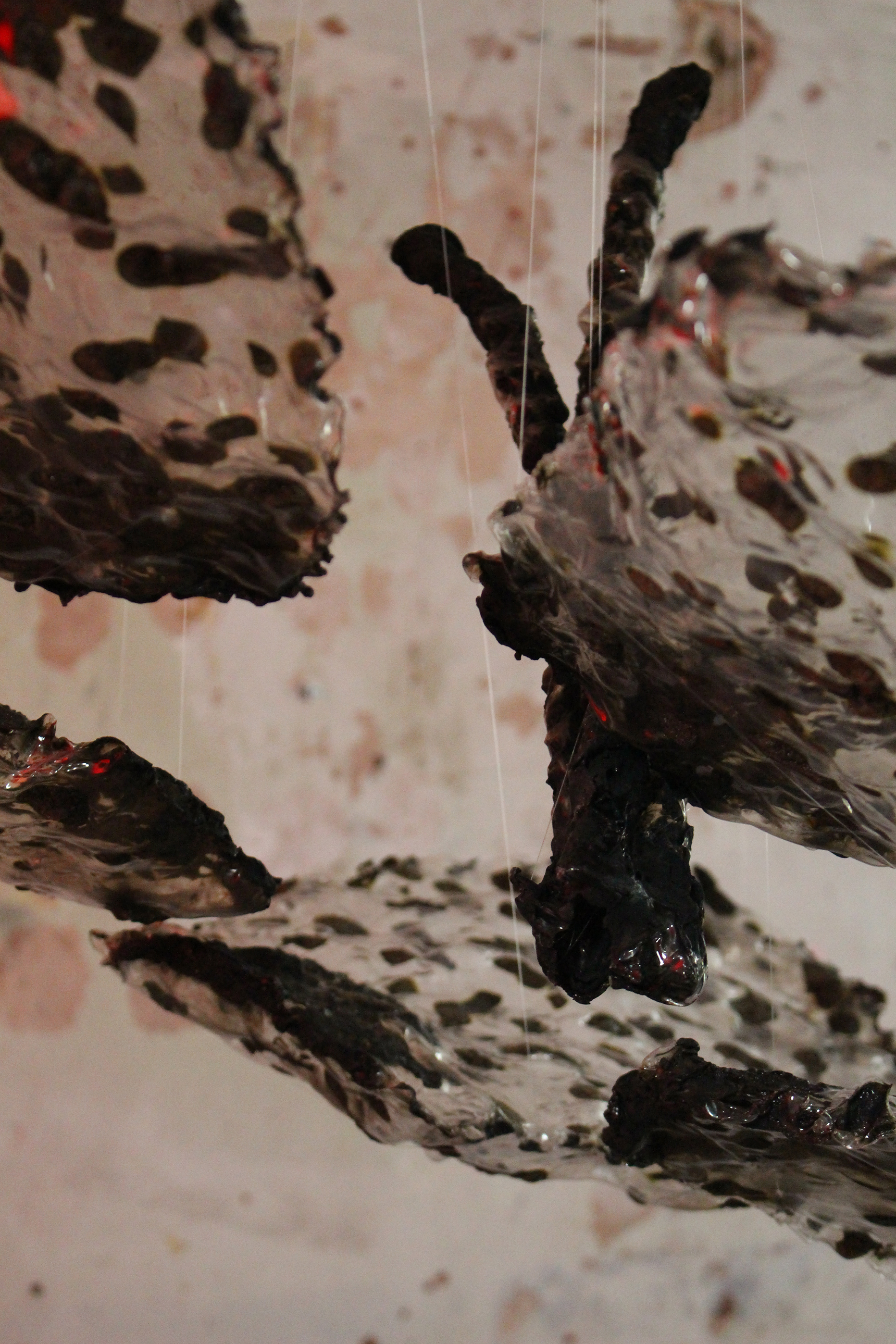賽璐珞是一種合成樹脂的名稱,是歷史上最早發明的熱可塑性樹脂,最初於1856年被創建為Parkesine,後在1869年被美國人 約翰·衛斯理·海特(John Wesley Hyatt)創造為Xylonite。於1870年由美國製造公司的登錄商標時被命名為Celluloid(賽璐珞)。
因能夠簡單成形,它被做為象牙的替代品開發。缺點為其極易燃,有著經過摩擦等容易發火的不耐久性,因此現在已經鮮少使用。
因能夠簡單成形,它被做為象牙的替代品開發。缺點為其極易燃,有著經過摩擦等容易發火的不耐久性,因此現在已經鮮少使用。
Celluloid is a class of compounds created from nitrocellulose and camphor, while added hyes and other agents. Generally considered the first thermoplastic, it had first established as Parkesine in 1856 and as Xylonite in 1869, before being registered as celluloid in 1870.
Celluloid is easily moulded and shaped, and it was first widely used as an ivory replacement.
Celluloid is easily moulded and shaped, and it was first widely used as an ivory replacement.
- Wikipedia
作品的表現方式延續之前其他作品的概念,以立體的方式去取代平面的表現手法。它是一個裝置藝術,同時也是一幅畫作。利用作品的立體化,觀看者可以有更多的選擇去決定從哪個角度欣賞作品,進一步的,我也樂意大家碰觸作品或者是非常近距離的觀察細節,這是在於傳統的展覽形式中,參觀者所無法體驗的;傳統的展覽中,觀眾無法直接近距離的接近作品,更不用說接觸作品了。
藉由材質本身的透明性質,太陽光穿過窗戶在“塑膠畫布”上增添色彩,並且也一併把窗戶的結構印上了。每個人都有自己獨特的方式去觀察作品,不同的位子可以看到作品的不同面,作品沒有一定要從那裡解讀,它是一個開放式的,觀眾可以自己決定如何去定義。
賞心悅目且讓人感到愉悅的花,是其中一種描述美的方式。花,很少讓人們聯想到不好的感受。真實的花,通常會散發出優雅的香氣。我刻意用賽璐珞當花的主材料,當花變成人工製成的塑膠花,並且燒繪出許多黑色的斑點,進而產生一些不好聞的味道,感人的感受是否改變了?
這個作品希望讓參觀者不只有視覺的體驗,並且能體驗到嗅覺的感受。
藉由材質本身的透明性質,太陽光穿過窗戶在“塑膠畫布”上增添色彩,並且也一併把窗戶的結構印上了。每個人都有自己獨特的方式去觀察作品,不同的位子可以看到作品的不同面,作品沒有一定要從那裡解讀,它是一個開放式的,觀眾可以自己決定如何去定義。
賞心悅目且讓人感到愉悅的花,是其中一種描述美的方式。花,很少讓人們聯想到不好的感受。真實的花,通常會散發出優雅的香氣。我刻意用賽璐珞當花的主材料,當花變成人工製成的塑膠花,並且燒繪出許多黑色的斑點,進而產生一些不好聞的味道,感人的感受是否改變了?
這個作品希望讓參觀者不只有視覺的體驗,並且能體驗到嗅覺的感受。




Continuing the notion of converting a two-dimensional painting into a three-dimensional work, this piece offers the audience a variety of choices for observing and interacting with it. Additionally, in traditional exhibitions, people typically cannot get too close or touch the art. However, I welcome the audience to touch this piece and to explore behind the flower, engaging with it.
The piece uses light from the window, reflecting its shape and light onto a plastic canvas and plastic flower. The audience can view it from almost every angle. As people explore the work from their unique perspectives, they can decide how they prefer to analyze the artwork and see themselves within the space.
A flower represents beauty and is a pleasant object to admire; no one will associate the flower with something outrageous.
By using celluloid film to transfer a flower via a toxic burn pattern, it acquires many flecking burn dots, altering its delicate nature. While a real flower emits a graceful odor, the combination with burned plastic eliminates the joyful scent, creating a toxic and artificial aroma. Especially after burning, the chemical process alters the celluloid film, emitting a pungent odor.
This work not only engages the audience visually but also provides an olfactory sensation. People need to be quite close to the flower to experience this unexpected aroma.
The piece uses light from the window, reflecting its shape and light onto a plastic canvas and plastic flower. The audience can view it from almost every angle. As people explore the work from their unique perspectives, they can decide how they prefer to analyze the artwork and see themselves within the space.
A flower represents beauty and is a pleasant object to admire; no one will associate the flower with something outrageous.
By using celluloid film to transfer a flower via a toxic burn pattern, it acquires many flecking burn dots, altering its delicate nature. While a real flower emits a graceful odor, the combination with burned plastic eliminates the joyful scent, creating a toxic and artificial aroma. Especially after burning, the chemical process alters the celluloid film, emitting a pungent odor.
This work not only engages the audience visually but also provides an olfactory sensation. People need to be quite close to the flower to experience this unexpected aroma.